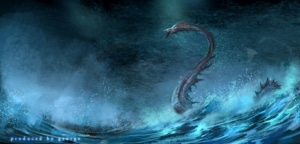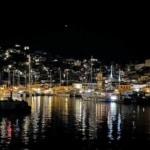Learn more about sail trim with either NauticEd’s FREE Basic Sail Trim Course for any aspiring sailor, or learn more comprehensive techniques with the Advanced Sail Trim online course.
Katabatic Winds
The old tales of sea monsters came ripping back to me as I was experiencing my very own terrifying version. Place – the very beautiful Marlborough Sounds in New Zealand.
Well actually not so terrifying and not REALLY a sea monster BUT … it makes for a great start to this story. The day before, my friend Mike and I were walking the famous Queen Charlotte track overlooking Queen Charlotte Sound at the top end of the South Island, New Zealand. We were spending a week boating, fishing, diving, wakeboarding, camping and exploring the Marlborough Sounds – real boy stuff. We came upon a clearing that allowed us to peer down through the towering native trees into the sound about 1000 feet below and saw something incredibly fascinating. We spent about 20 minutes starring at the effect of katabatic winds blasting down the valleys and exploding into the water. The word exploding is well founded here as we could see the spray flying in to the air each time one of these winds hit the water.
I’ve taken the following directly from Wikipedia which describes this effect. UPDATE: Katabatic Wind is also known as “Williwaw” in the Pacific Northwest and Gulf Islands….
>>>>>>>>>>>>
Katabatic Winds
A katabatic wind, from the Greek word katabatikos meaning “going downhill”, is the technical name for a drainage wind, a wind that carries high density air from a higher elevation down a slope under the force of gravity. Such winds are sometimes also called fall winds. Katabatic winds can rush down elevated slopes at hurricane speeds, but most are not that intense and many are on the order of 10 knots (18 km/h) or less.
Not all downslope winds are katabatic. For instance, winds such as the Foehn, Chinook or Bergwind, are rain shadow winds where air driven upslope on the windward side of a mountain range drops its moisture and descends leeward drier and warmer. Examples of true katabatic winds include the Bora (or Bura) in the Adriatic, the Bohemian Wind or Böhmwind in the Ore Mountains, theMistral, the Santa Ana in southern California, the Tramontane and the Oroshi in Japan. Another example is “The Barber,” an enhanced katabatic wind that blows over the town of Greymouth inNew Zealand when there is a southeast flow over the South Island. It is a wind that is known in the area for its coldness.
 Theory
Theory
A katabatic wind originates from radiational cooling of air atop a plateau, a mountain, glacier, or even a hill. Since the density of air is inversely proportional to temperature, the air will flow downwards, warming adiabatically as it descends. The temperature of the wind depends on the temperature in the source region and the amount of descent. In the case of the Santa Ana, for example, the wind can (but does not always) become hot by the time it reaches sea level. In the case of Antarctica, by contrast, the wind is still intensely cold.
The entire near-surface wind field over Antarctica is largely determined by the katabatic winds, particularly outside the summer season, except in coastal regions when storms may impose their own wind field.
Impacts
Katabatic winds are most commonly found blowing out from the large and elevated ice sheets of Antarctica and Greenland. The buildup of high-density cold air over the ice sheets and the elevation of the ice sheets brings into play enormous gravitational energy. Where these winds are concentrated in restricted areas in the coastal valleys, the winds blow well over hurricane force.[1] In Greenland, these winds are called Piteraq and are most intense whenever a low-pressure area approaches the coast.
In a few regions of continental Antarctica, the snow is scoured away by the force of the katabatic winds, leading to “dry valleys” (or “Antarctic oasis“) such as the McMurdo Dry Valleys. Since the katabatic winds are descending, they tend to have low relative humidity which desiccates the region. Other regions may have a similar but lesser effect, leading to “blue ice” areas where the snow is removed and the surface ice evaporates but is replenished by glacier flow from upstream.
In the Fuegian Archipelago (or Tierra del Fuego) in South America as well as in Alaska, a wind known as a williwaw is a particular danger to harbouring vessels. Williwaws originate in the snow and ice fields of the coastal mountains, and while they commonly blow as high as 100 knots, 200-knot williwaws have been reported.
>>>>>>>>>>>>
Here is a video we shot of these tubes of wind smashing vertically into the water far below us. Look for the telltale ripples changing the color of the water.
Pretty amazing right? So when these winds hit the water traveling at a steep angle it acts like a tube of air hitting the water then expanding out in all 360-degree directions dissipating as the expansion circle grows. So, imagine trying to sail in this? It’s a very frustrating experience and quite possibly dangerous. You could suffer a serious knockdown and depending on the strength, your crew members could be bashed around and tossed overboard or tossed around in the cabin causing injury. If your boom was not sheeted in, such an instantaneous change in wind direction could cause an automatic gybe bonking hard any crew as the boom raced across. i.e., these winds are really REALLY dangerous.
Now back to my sea monster story. So the next day after observing this phenomenon, Miek and I were walking along the beach when one of these winds slammed into the water about 200 ft (65m) in front of us. The force was so hard that water sprayed up into the air about 200 ft then it came ripping at us. A large Gulet-type wooden sailboat anchored between us and the impact zone was tossed around like a match stick. Mike ran for the woods like a little girl (hee hee sorry Mike) while I dropped into a rugby scrum pose getting low so I would not be knocked off my feet. Mike got off a photo a second too late as the wind screamed, swirled, gnashed, and gnarled through me whilst making a horrible howling sound. I would estimate that wind that hit me would have been doing about 65 knots. It lasted for about 2 seconds and was gone.
Here’s Mike’s photo – I’ve added the opaque shape just to help the imagination of the monster but – that was an experience not to be forgotten. One thing is obviously apparent – I would have hated to have my sails up in that. No matter what your experience, THAT would not have been good.
So what can you do? Sailing in these types of conditions, I’d be very tempted to drop sails and motor around. Gusts like these at the very least will scare the living daylight out of your crew or worse shred your sails and break some limbs. And the worst is that you’d have only a few seconds of warning.
The tip? If you are in windy conditions near mountains or you see this type of phenomenon happening, get the sails down. In sailing and boating always expect the unexpected.
Perhaps now you can begin to believe the origins of a few sea monster stories.
Other than that – the Marlborough Sounds in New Zealand is something not to be missed in a lifetime. View this 360 panorama below I took of Ships Cove at the top end of Queen Charlotte Sound. Captain Cook spent many months here on his 3 world trips using the bay to rest, reprovision, reseal and repair his boats.
Take NauticEd Online Sailing Courses to get more sailing tips and tricks and the world’s most advanced sailing certification.
###
Blog Updated 9/26/2022.















